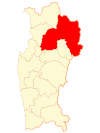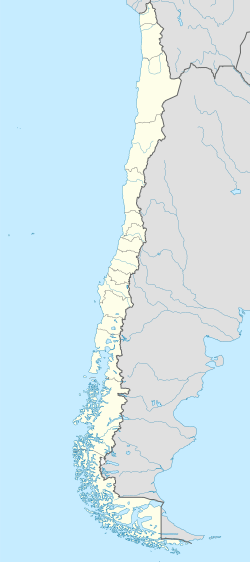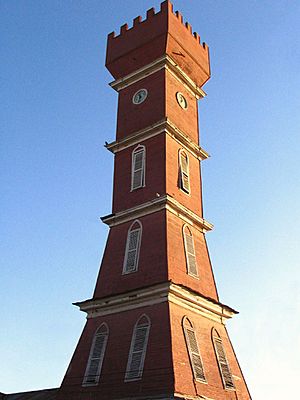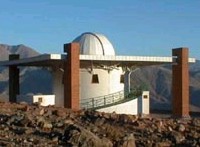Vicuña, Chile facts for kids
Quick facts for kids
Vicuña
|
|||||
|---|---|---|---|---|---|
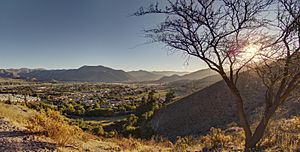
Vicuña as seen from nearby hills.
|
|||||
|
|||||
| Country | |||||
| Region | |||||
| Province | Elqui | ||||
| Vicuña | February 22, 1821 | ||||
| Government | |||||
| • Type | Municipality | ||||
| Area | |||||
| • Total | 7,609.8 km2 (2,938.2 sq mi) | ||||
| As of 2012 | |||||
| Elevation | 709 m (2,326 ft) | ||||
| Population
(2012 Census)
|
|||||
| • Total | 25,085 | ||||
| • Density | 3.29641/km2 (8.53766/sq mi) | ||||
| • Urban | 12,910 | ||||
| • Rural | 11,100 | ||||
| Demonym(s) | Vicuñense | ||||
| Sex | |||||
| • Men | 12,302 | ||||
| • Women | 11,708 | ||||
| Time zone | UTC−4 (CLT) | ||||
| • Summer (DST) | UTC−3 (CLST) | ||||
| Area code(s) | 56 + 51 | ||||
| Website | Official website: http://www.munivicuna.cl/ | ||||
Vicuña is a city and a commune (like a local district) in Chile. It is located in the Coquimbo Region, within the Elqui Province. The city was founded a long time ago to help Chile control the beautiful Elqui Valley.
A famous poet named Gabriela Mistral was born here in 1889. She even won the Nobel Prize in Literature! Vicuña shares its borders with other Chilean towns and even with Argentina to the east. The main city of Vicuña manages the whole commune, which is part of the Valle de Elqui.
Contents
History of Vicuña
Vicuña was officially started on February 22, 1821. It was founded by a military leader named Colonel Joaquín Vicuña Larraín. He was ordered to do so by Bernardo O'Higgins, who was a very important figure in Chile's history.
When it was first founded, the city was called Villa de San Isidro de Vicuña. Later, in 1872, its name was made shorter to just Vicuña. This was done to honor its founder, Joaquín Vicuña Larraín.
Geography and Landscape
The Vicuña commune is very large, covering about 7,610 square kilometers. This makes it the biggest commune in its province and the second largest in all of Chile! It includes most of the middle and upper parts of the Elqui River basin, as well as the entire Turbio river.
The area has many mountains, with some peaks reaching over 4,000 meters high. There are also wide, flat plains in the valleys. These plains are perfect for growing special grapes used to make pisco, which is a type of brandy. Farmers also grow other fruits and vegetables here.
Population and People
According to a census from 2002, Vicuña had a population of 24,010 people. This included 12,302 males and 11,708 females. The population grew by about 10.8% between 1992 and 2002.
About 12,910 people live in the city area of Vicuña. The other 11,100 people live in the countryside areas of the commune.
What is Vicuña Known For?
Vicuña is a very important place for making pisco. A big company called Cooperativa Agrícola Pisquera Elqui Limitada (CAPEL) has a main pisco factory here. The economy of Vicuña mostly relies on growing grapes, fruits, grains, and vegetables.
Other important activities include raising sheep and mining for iron and copper. In recent years, tourism has become very popular. This is because of the nice hotels and restaurants in the area.
Stargazing and Observatories
Vicuña is famous for its clear skies. It has about 300 clear days and nights every year! Because of this, several large astronomical observatories are located nearby. One popular one for tourists is the Mammalluca Observatory.
Fun Places to Visit
The city of Vicuña has many buildings that are over 100 years old. In the city square, you can see sculptures that honor Gabriela Mistral, the famous poet.
Other interesting places to visit include:
- The Temple of the Immaculate Conception, a beautiful church.
- The Bauer Tower, which has the local tourism office.
- The Gabriela Mistral museums, where you can learn more about her life and work.
Just a few kilometers outside of town, you can explore the "Route of the Grappa." This route lets you visit different pisco factories like Ruta Norte, Capel, and Mistral. The Mammalluca Observatory, about 9 km north of Vicuña, offers special tours and educational programs. You can also visit the Cerro Tololo Inter-American Observatory for daily tours.
Climate
| Climate data for Vicuña, elevation 620 m (2,030 ft) | |||||||||||||
|---|---|---|---|---|---|---|---|---|---|---|---|---|---|
| Month | Jan | Feb | Mar | Apr | May | Jun | Jul | Aug | Sep | Oct | Nov | Dec | Year |
| Mean daily maximum °C (°F) | 28.3 (82.9) |
28.6 (83.5) |
27.5 (81.5) |
24.8 (76.6) |
22.5 (72.5) |
20.4 (68.7) |
19.7 (67.5) |
21.0 (69.8) |
23.7 (74.7) |
25.1 (77.2) |
26.6 (79.9) |
27.7 (81.9) |
24.7 (76.4) |
| Daily mean °C (°F) | 19.8 (67.6) |
19.6 (67.3) |
17.9 (64.2) |
15.3 (59.5) |
13.3 (55.9) |
11.4 (52.5) |
11.4 (52.5) |
12.0 (53.6) |
14.0 (57.2) |
15.5 (59.9) |
16.9 (62.4) |
19.3 (66.7) |
15.5 (59.9) |
| Mean daily minimum °C (°F) | 12.0 (53.6) |
11.5 (52.7) |
10.2 (50.4) |
8.2 (46.8) |
6.8 (44.2) |
5.8 (42.4) |
5.8 (42.4) |
5.4 (41.7) |
6.9 (44.4) |
8.0 (46.4) |
8.6 (47.5) |
10.3 (50.5) |
8.3 (46.9) |
| Average precipitation mm (inches) | 0.2 (0.01) |
3.4 (0.13) |
0.3 (0.01) |
4.6 (0.18) |
20.2 (0.80) |
49.6 (1.95) |
27.9 (1.10) |
35.9 (1.41) |
4.2 (0.17) |
9.3 (0.37) |
0.0 (0.0) |
1.5 (0.06) |
157.1 (6.19) |
| Average relative humidity (%) | 61 | 62 | 65 | 66 | 63 | 61 | 61 | 61 | 60 | 60 | 57 | 58 | 61 |
| Source: Bioclimatografia de Chile | |||||||||||||
See also
 In Spanish: Vicuña (Chile) para niños
In Spanish: Vicuña (Chile) para niños



